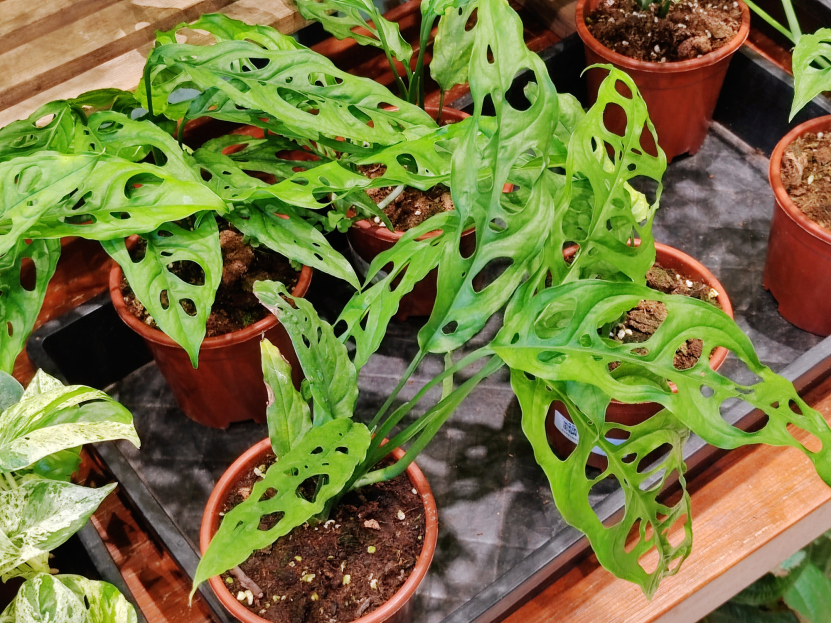
The Monstera Obliqua, often referred to as the "Swiss Cheese Plant" due to its distinctive, hole-punched leaves, is one of the most coveted houseplants among collectors. Known for its delicate, fenestrated leaves and slow-growing nature, this plant is not only a stunning addition to any indoor garden but also requires specific care to thrive. Here’s everything you need to know about keeping your Monstera Obliqua healthy and happy.
Monstera Obliqua thrives in bright, indirect light. It is native to the tropical rainforests of Central and South America, where it grows under the canopy of larger trees, receiving filtered light. To replicate this environment, place your Monstera Obliqua near a bright window with indirect sunlight. Avoid direct sunlight, as it can scorch the delicate leaves, causing brown spots and damage. If the light is too low, the plant may become leggy, and the characteristic holes in the leaves may not develop properly.
Like many tropical plants, Monstera Obliqua enjoys moderate watering. It's important to allow the top 1 to 2 inches of soil to dry out between waterings, as the plant does not like to sit in soggy soil. Overwatering can lead to root rot, a common issue with this species.
Water the plant thoroughly until water drains from the bottom of the pot, but make sure the plant doesn’t sit in excess water. During its growing season (spring and summer), you may need to water more frequently, but in the fall and winter, when the plant is dormant, reduce watering. Always check the soil moisture before watering to ensure the plant isn’t overwatered.
Monstera Obliqua thrives in warm temperatures ranging from 65°F to 80°F (18°C to 27°C). It’s important to avoid placing this plant in cold drafts or areas where temperatures drop below 50°F (10°C), as it is sensitive to the cold.
This plant also requires high humidity to flourish. The humidity levels should ideally be between 60% and 80%. If the air in your home is too dry, especially in winter, you can increase humidity by misting the leaves, using a humidity tray, or placing the plant in a more humid room, like a bathroom or kitchen. A humidifier can also be a great way to maintain the right moisture levels for your Monstera Obliqua.
Monstera Obliqua prefers well-draining, lightweight soil that retains some moisture but does not stay soggy. A good mix for this plant includes a combination of peat, perlite, and orchid bark. This will allow for proper drainage while still holding enough moisture for the plant’s roots.
Fertilize your Monstera Obliqua during its growing season (spring and summer) with a balanced, water-soluble fertilizer diluted to half strength. You can feed it every 4-6 weeks to encourage healthy growth. In the fall and winter, when the plant is dormant, you can stop fertilizing. Over-fertilizing can lead to burnt roots, so always follow the recommended dosage.
Repotting your Monstera Obliqua is necessary every 1-2 years, or when the plant becomes root-bound. This is especially important as the plant’s roots need space to grow. When choosing a pot, select one that is 1-2 inches larger than the current pot to allow for healthy root development. Be sure your new pot has drainage holes to prevent waterlogging.
Repotting is best done in the spring or early summer when the plant is actively growing. When repotting, gently remove the plant from its current pot and place it in the new one with fresh, well-draining soil. After repotting, wait a few days before watering to allow the plant to adjust to its new home.
Monstera Obliqua is a slow grower, but it can eventually become quite large. Pruning can help keep the plant in check and encourage bushier growth. You can trim back any long or leggy stems using clean, sharp scissors or pruning shears.
Removing dead or yellowing leaves is also important to maintain the plant’s appearance and overall health. This will help prevent any pests or diseases from taking hold and affecting the rest of the plant.
Unfortunately, Monstera Obliqua is not pet-safe. Like many other plants in the Monstera family, it contains calcium oxalate crystals, which can cause irritation to pets if ingested. Symptoms of poisoning in pets may include drooling, vomiting, and difficulty swallowing. If you have pets that tend to chew on plants, it’s best to keep this one out of their reach to avoid any potential issues.
Monstera Obliqua can be propagated easily through stem cuttings. To propagate, take a cutting that includes a node (the small bump on the stem where new growth occurs). Place your new cutting in water or soil, and it should root within a few weeks.
If propagating in water, change the water regularly to prevent stagnation, and once the roots are a few inches long, transplant the cutting into soil. Keep the new plant in a warm, bright spot to encourage healthy growth.